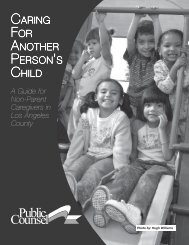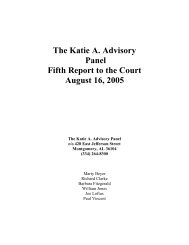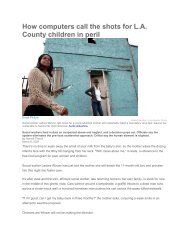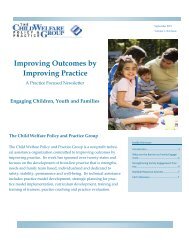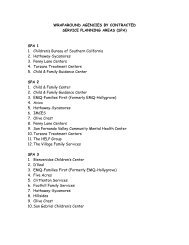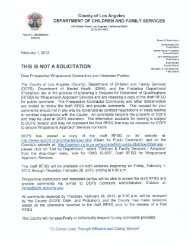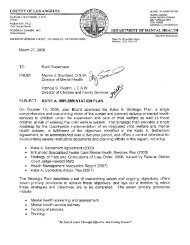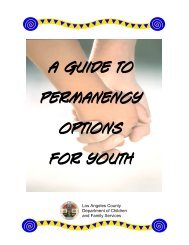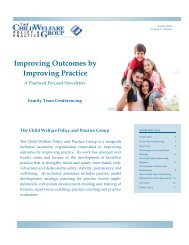Los Angeles County Self-Assessment Report
Los Angeles County Self-Assessment Report
Los Angeles County Self-Assessment Report
Create successful ePaper yourself
Turn your PDF publications into a flip-book with our unique Google optimized e-Paper software.
the CDSS - facilitated Focus Groups, and the L.A. <strong>County</strong> <strong>Self</strong>-<strong>Assessment</strong> Team<br />
meetings. Participants were asked how they feel DCFS and Probation are performing<br />
in the core areas of safety, permanency, and well-being for children, whether or not<br />
they have noticed any changes in performance since the last federal review, and what<br />
resource issues or practices in child welfare did they see as affecting performance in<br />
the three core areas already mentioned.<br />
<strong>Los</strong> <strong>Angeles</strong> <strong>County</strong> – Where Our Children Live, Grow, and Learn<br />
<strong>Los</strong> <strong>Angeles</strong> <strong>County</strong> is, in terms of population, the largest county in California and the<br />
United States. It is very diverse in its geography, racial, ethnicity and socio-economic<br />
make up. In addition to its urban core, the <strong>County</strong> includes vast areas of high desert,<br />
valleys, mountains and 76 miles of beaches. Figures from the U.S. Census Bureau<br />
give an estimated 2006 population of 9,948,081 residents.<br />
The county is home to 88 incorporated cities and many unincorporated areas, 81<br />
school districts, 1,894 schools, more than 1,400 parks, 235 community libraries, 68<br />
law enforcement agencies and thousands of community-based organizations. As of<br />
2004, the county's population is larger than the individual populations of 42 states<br />
considered separately (and on that basis is more populous than the aggregate of the<br />
11 least populous states) and is home to over a quarter of all California residents.<br />
<strong>Los</strong> <strong>Angeles</strong> <strong>County</strong> is home to 1.2 million families and almost 3 million children (0-<br />
17 years). Fifty-one percent of households have children less than 18 years of age.<br />
These children account for about one third of California’s child population. More<br />
than half of all children in L.A. <strong>County</strong> are under 10 years of age; 27% are under 5<br />
years; and 27% were ages 5 to 9 years. Close to 30% were 10 to 14 years, and<br />
16% were between 15 and 17 years old. About 60% are Latino children, almost<br />
10% are African-American, about 10% are Asian/Pacific Islander, and less than 1%<br />
are American Indian. The remaining 20% are non-Hispanic White children. In 2007,<br />
59% of children were speaking a language other than English at home.<br />
Employment, Income and Poverty in <strong>Los</strong> <strong>Angeles</strong> <strong>County</strong>:<br />
The per capita family income in L.A. <strong>County</strong> is $24,705 and the median household<br />
income increased from $42,045 in 2000 to $48,248 in 2005 (childrennow.org).<br />
Eighty-eight percent of households have at least one working parent, 23% of the<br />
children are living in poverty, and 11% of households are receiving food stamps<br />
(childrennow.org). The unemployment rate in 2004 was 6.6%, reduced to 5.2% in<br />
September, 20007, and then increased to 6% in January, 2008.<br />
7



